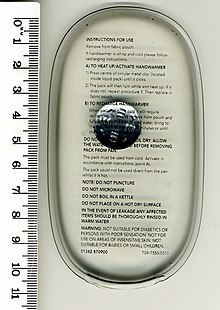Sodium acetate
| Structural formula | ||||||||||||||||||||||
|---|---|---|---|---|---|---|---|---|---|---|---|---|---|---|---|---|---|---|---|---|---|---|

|
||||||||||||||||||||||
| General | ||||||||||||||||||||||
| Surname | Sodium acetate | |||||||||||||||||||||
| other names | ||||||||||||||||||||||
| Molecular formula | C 2 H 3 NaO 2 | |||||||||||||||||||||
| Brief description |
colorless, crystalline salt |
|||||||||||||||||||||
| External identifiers / databases | ||||||||||||||||||||||
|
||||||||||||||||||||||
| properties | ||||||||||||||||||||||
| Molar mass | 82.03 g mol −1 (anhydrous) 136.08 g mol −1 (trihydrate) |
|||||||||||||||||||||
| Physical state |
firmly |
|||||||||||||||||||||
| density |
1.52 g cm −3 (20 ° C, anhydrous) |
|||||||||||||||||||||
| Melting point |
Decomposition at 324 ° C |
|||||||||||||||||||||
| solubility |
good in water (365 g l −1 at 20 ° C) (anhydrous) (613 g / l at 20 ° C) (trihydrate) |
|||||||||||||||||||||
| safety instructions | ||||||||||||||||||||||
|
||||||||||||||||||||||
| Toxicological data | ||||||||||||||||||||||
| Thermodynamic properties | ||||||||||||||||||||||
| ΔH f 0 |
−708.8 kJ / mol |
|||||||||||||||||||||
| As far as possible and customary, SI units are used. Unless otherwise noted, the data given apply to standard conditions . | ||||||||||||||||||||||
Sodium acetate is a colorless salt that smells faintly like vinegar. It is the sodium salt of acetic acid and is formed, for example, when caustic soda , sodium carbonate or sodium hydrogen carbonate react with acetic acid. Sodium acetate is properly abbreviated as NaOAc. Occasionally, however, the wrong abbreviation NaAc is found (the abbreviation Ac only stands for an acetyl group −C (O) CH 3 ). The meaning of the abbreviation Ac only applies in the field of organic chemistry . In inorganic chemistry , Ac is the symbol for the element actinium .
Manufacturing
On a laboratory scale it can e.g. B. obtained by the reaction of sodium carbonate (soda) and acetic acid:
Likewise z. For example, by neutralization of sodium hydroxide with acetic acid:
properties
Sodium acetate crystallizes from aqueous solutions with 3 mol of water of crystallization : Na (CH 3 COO) 3 H 2 O. This trihydrate forms large, colorless crystals and is readily soluble in water (612 g / l at 20 ° C) and dissolves at 58 ° C in your own crystal water. At a higher temperature (~ 120 ° C) the water of crystallization evaporates and anhydrous sodium acetate Na (CH 3 COO), abbreviated as NaOAc, is formed. The anhydrous salt is also colorless, flammable, but difficult to ignite, it is hygroscopic and readily soluble in water (365 g / l at 20 ° C). Aqueous solutions of sodium acetate and acetic acid form a buffer solution , which means that the pH value remains almost constant even after adding (small amounts) of acid or lye .
use
Sodium acetate is the food additive E 262a . It is used as an acidity regulator and preservative for fruit and vegetables in cans and glasses, bread , fish in all variations, delicatessen salads, mayonnaise and salad dressings . It is also used in combination with various fruit acids ( malic acid , citric acid , tartaric acid , etc.) as an ingredient in potato chips with the “ Salt & Vinegar ” flavor .
Sodium acetate is also sometimes used in cosmetics , where it acts as a buffer as well as to mask the basic odor.
For demonstration experiments, crystals that resemble icebergs can easily be produced from oversaturated sodium acetate solution. For this purpose, seed crystals are placed on the bottom of a beaker and slowly doused with a supersaturated sodium acetate solution. Crystals form immediately and pile up to form an iceberg-like tower.
The so-called " instant ice " is based on the same principle. A (transparent) vessel is filled with the solution and the surface of the solution is touched with the fingertip. This crystallizes out immediately and becomes solid like ice. (The fingertip replaces the seed crystal here.)
The crystallization of the sodium acetate is strongly exothermic , so that a lot of energy is released in the form of heat. It is used in heat cushions , whereby the trihydrate in regenerable hand warmers serves as a latent heat store .
As latent heat storage
Up to 2.5 MWh of heat per 20-foot ISO container (approx. 33 m³) can be transported in retrofitted tank containers that contain sodium acetate as a latent heat store , which corresponds to approx. 75 kWh per m³. For example, the waste heat from block-type thermal power stations can be used.
Web links
Individual evidence
- ↑ Entry on SODIUM ACETATE in the CosIng database of the EU Commission, accessed on December 28, 2019.
- ↑ Entry on E 262: Sodium acetates in the European database for food additives, accessed on August 11, 2020.
- ↑ a b c d e f g h i j k l m n Entry on sodium acetate in the GESTIS substance database of the IFA , accessed on December 19, 2019(JavaScript required) .
- ↑ David R. Lide (Ed.): CRC Handbook of Chemistry and Physics . 90th edition. (Internet version: 2010), CRC Press / Taylor and Francis, Boca Raton, FL, Standard Thermodynamic Properties of Chemical Substances, pp. 5-22.
- ↑ a b TU Freiberg script (PDF; 943 kB).
- ↑ Jander, Blasius, Strähle: Introduction to the inorganic-chemical practical course . 14th edition. Hirzel, Stuttgart 1995, ISBN 978-3-7776-0672-9 , pp. 76-77.
- ↑ Enius.de
- ↑ Information on sodium acetate at haut.de , accessed on August 22, 2017.
- ^ Lecture at the University of Erlangen
- ↑ The mobile heat is well received in the container - article in the Augsburger Allgemeine.
- ↑ LaTherm: Mobile Storage Series November 5, 12, 2016, accessed May 13, 2019 .
- ↑ Wayback Machine. March 4, 2016, accessed May 13, 2019 .




